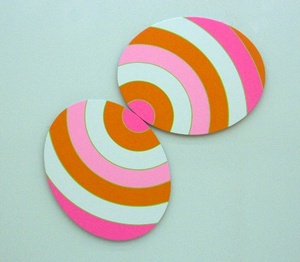
Aaron Parazette. Color Key 6, 2009
acrylic on linen
Aaron Parazette: Air Drop and Anders Ruhwald: Almost Nothing
by Matt Stromberg
October 4, 2009
This two-person show featuring brightly hued, hard-edged geometric paintings and rough-hewn monochromatic sculptures, is tied together by the artists' use of a post-minimalist vocabulary and a focus on craft. Aaron Parazette's abstract geometric paintings on shaped canvases recall those of Ellsworth Kelly and Robert Mangold, albeit with a highly keyed-up palette and on a more intimate scale. Like these artists, Parazette's works are self-contained worlds. Planes of colors, arranged in grids or concentric circles, are cropped by the edges of the unusually shaped supports. They are often continued on contiguous canvases, as if these diptychs or triptychs were removed from some larger whole. In Color Key 6 (2009), arcs of pink, orange, and white cover two oval-shaped canvases, which meet directly at the center of a hot pink circle, spilling across both canvases. Two thin green lines--one dark and one light--limn each color band, accentuating the optical effect. These paintings work best when they reflect a thoughtful balance between color, shape and support, while incorporating a subtle nod to historical precedents.
Contrary to the energetic paintings in Parazette's "Air Drop" show, the exhibition of Anders Ruhwald's monochromatic ceramic sculptures is appropriately called "Almost Nothing." Ruhwald has pared down his works to the basics of texture and form, stressing the primacy of the material. Like Robert Ryman's paintings, his use of white serves to focus our attention on his heavily worked surfaces. Also like Ryman, his marks are devoid of gesture. Unlike his minimalist predecessors however, his abstract forms are almost familiar to us (a tree stump, a vase), but are altered in ways that makes them unsettling, and somewhat comedic. They hover somewhere between minimalist ciphers and common objects. "What would this material do, if left to its own devices?" they seem to be asking. While some fashion themselves into crude variations of common forms, others simply struggle to be of some use: Marked, a three-legged object that mimics and marks a corner, Allting, which juts out of the wall near the ceiling and resembles a pipe, or Mono (3 in itself) (all works 2009), a rectangular slab placed on the wall like a blank canvas. While these works can be seen as almost nothing, what makes them most interesting is when they aspire to be almost something.